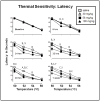Thermal sensitivity as a measure of spontaneous morphine withdrawal in mice
- PMID: 23416790
- PMCID: PMC3631460
- DOI: 10.1016/j.vascn.2013.02.003
Thermal sensitivity as a measure of spontaneous morphine withdrawal in mice
Abstract
Introduction: Opioid withdrawal syndrome is a critical component of opioid abuse and consists of a wide array of symptoms including increases in pain sensitivity (hyperalgesia). A reliable preclinical model of hyperalgesia during opioid withdrawal is needed to evaluate possible interventions to alleviate withdrawal. The following study describes a method for assessing increases in thermal sensitivity on the hotplate in a mouse model of spontaneous morphine withdrawal.
Methods: C57BL/6J mice received 5.5days of 30, 56, or 100mg/kg morphine or saline (s.c., twice daily). In Experiment I, thermal sensitivity data were collected at baseline and at 8, 24, 32, 48h and 1week following the final injection. Thermal sensitivity was assessed by examining latency to respond on a hotplate across a range of temperatures (50, 52, 54, and 56°C). In Experiment II, 0.01mg/kg buprenorphine was administered 30min prior to each testing session during the withdrawal period. In Experiment III, jumping during a 30min period was assessed at baseline and at 0, 8, 24, 32, and 48h following the final morphine injection.
Results: During the withdrawal period, thermal sensitivity increased significantly in all morphine-treated mice as compared to saline-treated mice. Thermal sensitivity was greater in mice treated with 56mg/kg morphine compared to 30mg/kg and peaked earlier than in mice treated with 100mg/kg (32h v 1wk). The increase in thermal sensitivity following 56mg/kg morphine was attenuated by a dose of buprenorphine that did not produce antinociception alone (i.e., 0.01mg/kg). In general, the results of the jumping experiment paralleled those obtained in Experiment I.
Discussion: Response latency on the hotplate is a reliable and sensitive measure of spontaneous morphine withdrawal in mice, making it an ideal behavior for assessing the potential of medications and environmental interventions to alleviate opioid withdrawal.
Copyright © 2013 Elsevier Inc. All rights reserved.
Figures




References
-
- Angst MS, Koppert W, Pahl I, Clark DJ, Schmeiz M. Short-term infusion of the mu-opioid agonist remifentanil in humans causes hyperalgesia during withdrawal. Pain. 2003;106:49–57. - PubMed
-
- Balter RE, Dykstra LA. The effect of environmental factors on morphine withdrawal in C57BL/6J mice: running wheel access and group housing. Psychopharmacology. 2012;224(1):91–100. - PubMed
-
- Compton P, Athanasos P, Elashoff D. Withdrawal hyperalgesia after acute opioid physical dependence in non addicted humans: a preliminary study. J Pain. 2003;4:511–519. - PubMed
-
- Connock M, Juarez-Garcia A, Jowett S, Frew E, Liu Z, Taylor RJ, Fry-Smith A, Day E, Lintzeris N, Roberts T, Burls A, Taylor RS. Methadone and buprenorphine for the management of opioid dependence: a systematic review and economic evaluation. Health Technol Assess. 2007;11(9):1–171. iii–iv. Review. - PubMed
-
- Crain SM, Shen KF. Naloxone rapidly evokes endogenous kappa opioid receptor-mediated hyperalgesia in naïve mice pretreated briefly with GM1 ganglioside or in chronic morphine-dependent mice. Brain Res. 2007;1167:31–4. - PubMed
MeSH terms
Substances
Grants and funding
LinkOut - more resources
Full Text Sources
Other Literature Sources

